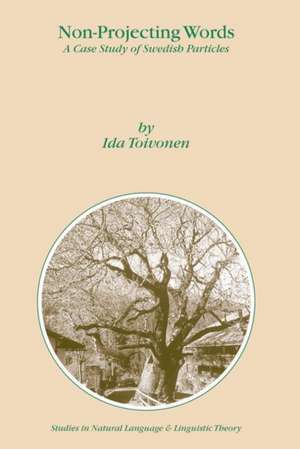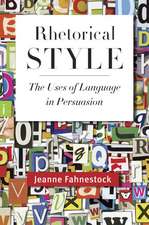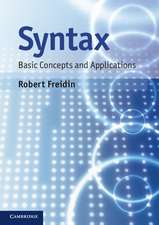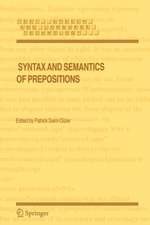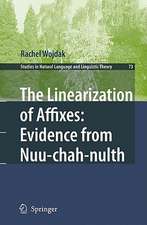Non-Projecting Words: A Case Study of Swedish Particles: Studies in Natural Language and Linguistic Theory, cartea 58
Autor I. Toivonenen Limba Engleză Hardback – 30 sep 2003
Particles have long constituted a puzzle for Germanic syntax, as they exhibit properties of both morphological and syntactic constructs. Although non-projecting words have appeared in the literature before, it has gone largely unnoticed that such structures violate the basic tenets of X-bar theory. This work identifies these violations and develops a formally explicit revision of X-bar theory that can accommodate the requisite "weak" projections.
The resulting theory, stated in terms of Lexical-Functional Grammar, also yields a novel classification of clitics, and it sheds new light on a range of recent theoretical proposals, including economy, multi-word constructions, and the primitives of lexical semantics. At an abstract level, we see that the modular, parallel-projection architecture of LFG is essential to the description of a variety of otherwise recalcitrant facts about non-projecting words.
| Toate formatele și edițiile | Preț | Express |
|---|---|---|
| Paperback (1) | 640.06 lei 6-8 săpt. | |
| SPRINGER NETHERLANDS – 30 sep 2003 | 640.06 lei 6-8 săpt. | |
| Hardback (1) | 644.82 lei 6-8 săpt. | |
| SPRINGER NETHERLANDS – 30 sep 2003 | 644.82 lei 6-8 săpt. |
Din seria Studies in Natural Language and Linguistic Theory
- 24%
 Preț: 808.03 lei
Preț: 808.03 lei - 18%
 Preț: 788.72 lei
Preț: 788.72 lei - 18%
 Preț: 958.56 lei
Preț: 958.56 lei - 15%
 Preț: 600.26 lei
Preț: 600.26 lei - 18%
 Preț: 947.67 lei
Preț: 947.67 lei - 15%
 Preț: 646.62 lei
Preț: 646.62 lei - 18%
 Preț: 723.56 lei
Preț: 723.56 lei - 15%
 Preț: 604.84 lei
Preț: 604.84 lei - 18%
 Preț: 952.09 lei
Preț: 952.09 lei - 15%
 Preț: 642.51 lei
Preț: 642.51 lei - 18%
 Preț: 947.50 lei
Preț: 947.50 lei - 15%
 Preț: 646.75 lei
Preț: 646.75 lei - 18%
 Preț: 1224.54 lei
Preț: 1224.54 lei - 15%
 Preț: 641.71 lei
Preț: 641.71 lei - 18%
 Preț: 2314.56 lei
Preț: 2314.56 lei - 18%
 Preț: 952.89 lei
Preț: 952.89 lei - 18%
 Preț: 1220.12 lei
Preț: 1220.12 lei - 15%
 Preț: 642.83 lei
Preț: 642.83 lei - 18%
 Preț: 944.19 lei
Preț: 944.19 lei - 15%
 Preț: 648.05 lei
Preț: 648.05 lei - 18%
 Preț: 952.57 lei
Preț: 952.57 lei - 18%
 Preț: 1729.61 lei
Preț: 1729.61 lei - 15%
 Preț: 644.95 lei
Preț: 644.95 lei - 15%
 Preț: 644.63 lei
Preț: 644.63 lei -
 Preț: 384.48 lei
Preț: 384.48 lei - 18%
 Preț: 1662.85 lei
Preț: 1662.85 lei - 18%
 Preț: 955.08 lei
Preț: 955.08 lei - 18%
 Preț: 952.40 lei
Preț: 952.40 lei -
 Preț: 386.81 lei
Preț: 386.81 lei
Preț: 644.82 lei
Preț vechi: 758.60 lei
-15% Nou
Puncte Express: 967
Preț estimativ în valută:
123.38€ • 128.82$ • 102.12£
123.38€ • 128.82$ • 102.12£
Carte tipărită la comandă
Livrare economică 05-19 aprilie
Preluare comenzi: 021 569.72.76
Specificații
ISBN-13: 9781402015311
ISBN-10: 1402015313
Pagini: 237
Ilustrații: XV, 237 p.
Dimensiuni: 155 x 235 x 18 mm
Greutate: 0.54 kg
Ediția:2003
Editura: SPRINGER NETHERLANDS
Colecția Springer
Seria Studies in Natural Language and Linguistic Theory
Locul publicării:Dordrecht, Netherlands
ISBN-10: 1402015313
Pagini: 237
Ilustrații: XV, 237 p.
Dimensiuni: 155 x 235 x 18 mm
Greutate: 0.54 kg
Ediția:2003
Editura: SPRINGER NETHERLANDS
Colecția Springer
Seria Studies in Natural Language and Linguistic Theory
Locul publicării:Dordrecht, Netherlands
Public țintă
ResearchCuprins
1. Introduction.- 1. Particles And X’-Theory.- 2. Swedish Clause Structure.- 3. Overview.- 2. Empirical Motivation.- 1. Particles As Non-Projecting Words.- 2. Arguments Against An XP Analysis.- 3. Arguments Against A Morphological Analysis.- 4. Particles and Clitics.- 5. Summary.- 3. Phrase Structure.- 1. Introduction.- 2. X’-Structure.- 3. X’-Principles.- 4. C-Structure To F-Structure Mappings.- 5. Linear Order.- 6. Economy of Expression.- 7. Summary of The C-Structure Theory.- 9. Conclusion.- 4. Verbal Particles In The Swedish VP.- 1. The C-Structure..- 2. The Structure-Function Mapping.- 3. Head-Adjunction.- 4. Recursion.- 5. Economy And Swedish Particles.- 6. Word Order: Apparent Problems.- 7. Summary.- 5. The Meaning of Swedish Particles.- 1. Resultsative Particles.- 2. Aspectual Particles.- 3. Idiomatic Verb-Particle Combinations.- 4. Summary.- 6. Other Germanic Languages.- 1. Danish.- 2. German.- 3. English.- 4. The Complex Particle Construction.- 5. An Overview of Germanic Particles.- 7. Conclusion.- 1. X’-Theory.- 2. Economy Of Expression.- 3. The Structure-Function Mapping.- 4. Resultative Predication.- 5. Clitics.- 6. Summary.- Appendix A. Economy of Expression.- 1. The Economy Principle.- 2. Economy and Swedish Clause Structure.- 2.1. Object shift.- 2.2. V2 and Economy.- References.- Index Of Names.- Index Of Subjects.
Recenzii
From the reviews:
"In this book, Toivonen has produced an exceptionally lucid document, one that I do not hesitate to recommend to students and colleagues … this is that rare volume that contributes to linguistic theory while being highly accessible. The book furthermore strikes an exemplary balance between description and analysis; it is rich in clearly organized and insightfully presented data … . This book makes an important contribution." (Peter Svenonius, Language, Vol. 84 (3), 2008)
"In this book, Toivonen has produced an exceptionally lucid document, one that I do not hesitate to recommend to students and colleagues … this is that rare volume that contributes to linguistic theory while being highly accessible. The book furthermore strikes an exemplary balance between description and analysis; it is rich in clearly organized and insightfully presented data … . This book makes an important contribution." (Peter Svenonius, Language, Vol. 84 (3), 2008)
